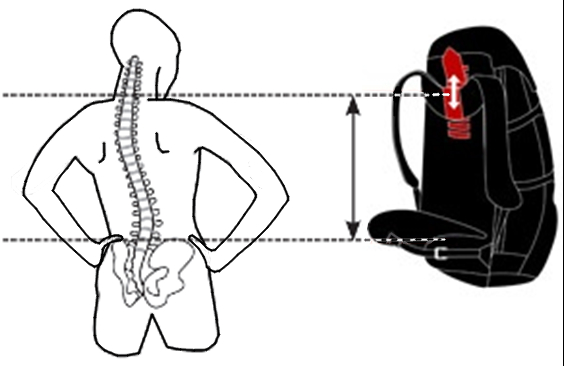Planning a multiday adventure, taking a short day hike or schlepping books from class to class? You need a backpack that fits your needs AND your body, correctly. Surprisingly, the size of the pack you choose, doesn't depend on your height, so what measurements do you need to choose the right pack?
 When sizing up a pack the first thing you want to do is measure your torso length. NAO staff can help you find this measurement. First, we will have you put a finger on the back of your neck and tilt your head back. You're looking for a bony point on your spine at the base of your neck and it is easier to find if you tilt your head back. Next, stand up straight and grab on to your hips, right at the hipbones, not at your waist or around your stomach. You should be able to feel the bones. Put your hands on your hips so that your thumbs are pointing towards each other behind your back. We will measure the distance from the bony point on your spine to the invisible line your thumbs are making. That is your torso length. Most people fall in a range between 14 and 21 inches. If your torso is less than 18 inches long, you'll typically take a small suspension system; 18 to 20 inches calls for a medium; 21 inches or more requires a large.
When sizing up a pack the first thing you want to do is measure your torso length. NAO staff can help you find this measurement. First, we will have you put a finger on the back of your neck and tilt your head back. You're looking for a bony point on your spine at the base of your neck and it is easier to find if you tilt your head back. Next, stand up straight and grab on to your hips, right at the hipbones, not at your waist or around your stomach. You should be able to feel the bones. Put your hands on your hips so that your thumbs are pointing towards each other behind your back. We will measure the distance from the bony point on your spine to the invisible line your thumbs are making. That is your torso length. Most people fall in a range between 14 and 21 inches. If your torso is less than 18 inches long, you'll typically take a small suspension system; 18 to 20 inches calls for a medium; 21 inches or more requires a large.
The next thing you need to figure out is if you are small, medium or large framed. This is pretty easy to do. Take your thumb and forefinger and place them around your wrist. If your fingers touch easily, then you are small framed. If your fingers don't touch, but just barely, then you are medium framed. If your fingers don't touch at all and couldn't even if you squeezed as hard as you could, your large framed.
Take your tape measure and wrap it around the top of your hips. The correct measurement is along the line that radiates out from your belly button to your sides and the high points of your hip bones. A properly positioned hip belt will straddle your hips about an inch above and below that latitude line, wrapping around the 2 pointy pelvic bones on the front of your body. The hip belt should ride on your hips, transferring the weight to your skeletal structure. It's because of this belt-to-bone contact that the belt is padded. Make sure the pads don't touch in front, you are looking for a pack that will fit around your hips and still leave around three inches of adjustment on each side of the buckle.
Some shoulder straps sprout from the harness in a Y, others in an H. Some you can adjust to suit your neck and shoulders. The straps should anchor to the pack just below the crest of your shoulders. From there, they should make a close-contact wrap of your shoulders. The bottom of the strap should rest at least a hand's width below your armpit so that it doesn't ride up. If the straps don't match the contours of your neck and shoulders, they will pinch and bruise.
 Once your hip belt and shoulder straps fit just right, feel for a strap that runs from the top of your shoulder strap up to the frame and tighten it.
Once your hip belt and shoulder straps fit just right, feel for a strap that runs from the top of your shoulder strap up to the frame and tighten it. These are stitched into the top of the shoulder straps, and they connect to the top of the pack frame. Ideally, they will form a 45° angle between your shoulder straps and the pack. Kept snug (but not too tight), they prevent the upper portion of a pack from pulling away from your body, which would cause the pack to sag on your lumbar region.
The mid-chest strap allows you to connect your shoulder straps, which can boost your stability. It can be useful to do so when traveling on uneven cross-country terrain where an awkward move could cause your pack to shift abruptly and throw you off-balance.
Move the strap up or down to its most comfortable position.
When fitting a pack to a child it is recommended that the load in the backpack not exceed 10-15 percent of your child's weight. Therefore, a 100-pound child should not carry a pack weighing more than 10-15 pounds. The heaviest items should always be placed closest to the back to diminish stress on the lumbar spine.